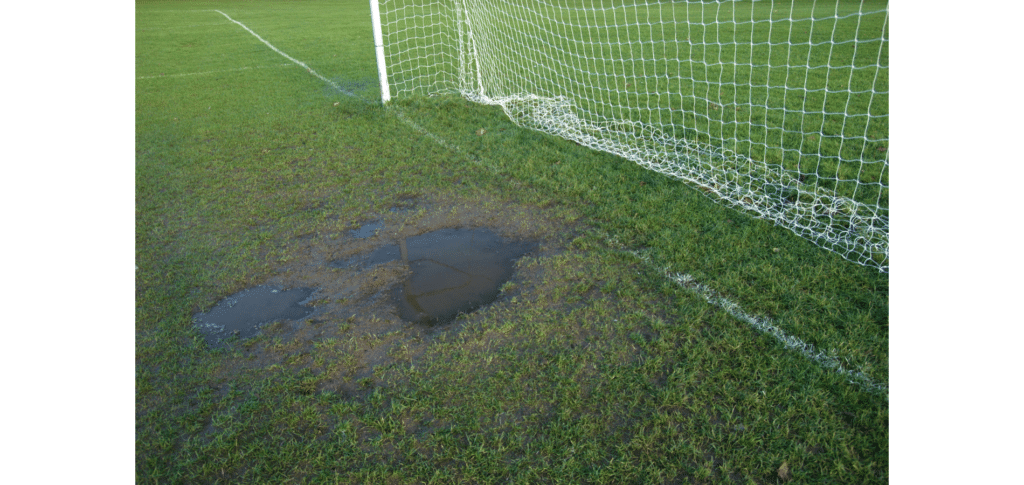The usual routines that take place prior to the commencement of football matches do tend to leave attentive viewers with a few unanswered questions.
It could be something as simple as the pre-match handshake between players, or the coin toss which decides the direction in which both teams will attack and defend for the first half.
Fans need to be enlightened on why such events happen, which is why in today’s article I’ll be talking about why soccer teams switch sides at the halftime interval.
To answer this succinctly…
Teams swap sides at halftime to neutralise any sporting advantage that a club could possibly receive due to defects on the field of play or adverse weather conditions.
For example, a strong gust of wind may blow in the opposite direction from where the away side is attacking, which could make completing short passes or long balls more difficult for the visiting team.
Or in a different scenario, the playing surface may have a slight incline that makes running in the direction of the slope more tiresome than if the pitch was flat across the entire surface.
So, the switching of sides is done in the spirit of fairness, as each team would have one half to benefit from the aforementioned unavoidable advantages.
Before I expand on the solution that I’ve just explained, I thought it would be worth pointing out what the halftime period is and the set duration of time for which it comes into effect.
How long does the halftime break last?
According to the Football Association’s Laws of the Game, all players participating in professional football matches are entitled to have a brief interlude, which in itself should not exceed 15 minutes in length.
The concept of halftime was constructed many years ago as the parties that oversaw the rules and legislation within the sport at the time, recognised the need for players to have a moment where they could take a break and recover from the intense competitive action of the first half.
In fact, you might want to check out an article that I’ve previously written which specifically looks into what footballers do during the halftime break.
So, there you have it!
The short 15-minute intermission that players receive during each game allows them to rest and re-energise, which is important as the human body is afforded time to heal itself, subsequently reducing the risk of injury occurrence too.
Why teams exchange sides at halftime
Now that we’ve covered the basic principle of the halftime concept, it’s time to look at three main factors why the switch occurs.
Let’s get started…
1. Muddy pitch surfaces

The pristine condition that many football pitches exist in today was not as commonplace in the recent past.
With modern technology facilitating impressive innovations such as under-soil heating and sprinkler systems that keep the grass moist and slick in all areas, the act of switching sides has gradually assumed less and less importance over the years.
Despite that, not every football club in the world can afford to employ qualified groundsmen to constantly and proactively maintain their pitches, which leads to cases where some parts of the field do not have sufficient amounts of grass coverage.
Such an issue would be further compounded on a rainy day, as once the soil comes into contact with large amounts of water, the surface turns into a muddy mess.
You only need to look at the state of the pitch in a past UEFA Champions League game between Juventus and Galatasaray to see the profound effect a poor surface can have on overall gameplay.
Muddy patches are largely a problem for goalkeepers, as they tend to form in and around the 6-yard box which make it difficult to predict the trajectory of shots that bounce and skid off of a poor surface.
2. Natural pitch slopes
Football pitches are built in with tiny slopes that serve to transport water to side line areas where it’s collected and drained effectively.
The presence of these small inclinations prevents grass fields from becoming waterlogged in situations where there is a severe downpour of rain.
Normally, these slopes are well designed so that they don’t have affect the gameplay of participants.
But for one reason or another – especially on grounds that are not inspected by competition regulators – some slopes may be slightly too steep, which actually hinders the teams attacking the end of the field where the incline heads towards.
Without exchanging sides, unfair advantage would be afforded to the which has to descend to the other end of the field in order to score.
So, halftime is in place to cancel out the benefit stemming from the pitch defect as each club would have an equal duration of 45 minutes to play on the affected field area.
3. Adverse weather conditions
You often hear commentators and pundits often referring to the difficulty that opposition teams encounter when playing through a cold and windy night at Stoke City’s Britannia Stadium.
It is a statement that rings true to a small extent, as strong gusts of wind can have a significant impact on:
- the flight trajectory of a ball when it is moving towards a goalkeeper
- trapping (controlling) the ball whilst it is descending from height
- passing the ball accurately over both short and long distances
As gusts of wind rarely ever lead to match postponements, the players of both sets of teams have to cope with such conditions throughout the game.
Strong winds can give teams unfair advantage as they can be able to benefit from unpredictable ball movements during set pieces like wide free kicks and corner kicks.
For instance, in a scenario where wind speeds were evidently higher towards the opposition goal, all a player would need to do is strike the ball in the direction of the wind with enough power.
The wind will then play its part through adding swerve to the ball which would certainly make things harder for the goalkeeper – who would need a good pair of goalkeeper gloves – when facing the cross or shot attempt.
Therefore, as winds usually travel in a certain direction for quite a bit of time, it’s imperative for both clubs to change sides at halftime so that they each benefit from this advantage brought about by nature, as opposed to just one team being able to exploit it.
To add onto this point, matches are often played after dawn and before sunset, which means that the direction of the sun’s rays can also provide one team with an advantage over their opponent.
If sunlight is able to significantly obstruct the eyeline view of a goalkeeper, they will struggle to see the ball as it approaches them – which ultimately impedes their overall performance as making saves and collecting crosses would become harder to execute.
It’s only fair that the goalkeepers of each team deal with the sunlight issue for 45 minutes instead of a situation where one goalkeeper grapples with it over a whole 90-minute period.
4. Fan entertainment

At the end of the day, football as a sport is played for the overall enjoyment of the fanbase that watches it.
Due to the circular or oval-like shape of a soccer stadium, not all fans in attendance at the grounds get a great view of events that take place during a match.
More particularly, the supporters who are seated behind the goals find it difficult to see things unfolding in the centre of the pitch and at the opposite end.
So, the halftime change over gives both sets of fans situated behind the goal nets an equal chance to see their team attack and score goals at the end of the field where they are seated (or standing).
This rule is particularly useful in matches where one side is dominating possession and territory in the opponent’s half, as these fans get to watch all the build up and intricate passing that takes place on that side.
Summary
To wrap things up, I’ll leave you with a short video that provides an excellent overview of why soccer teams switch sides at halftime:
So, just to recap, both teams swap sides after half time in a soccer game is to primarily promote equity by cancelling out the weather and pitch slope advantages that arise within competitive matches.
More so, switching sides affords the spectators usually situated behind the goals with a chance to see their team score goals and perform attacks at a much closer proximity which enhances entertainment value.
If you enjoy the content that I create and would like to buy me a coffee, then I’d really appreciate it!
Any money that I earn through this donation will be re-invested into more content for this website.
Additionally, by sending in a donation you’ll also receive a copy of my recently released 190+ page eBook on Soccer Ball Care, as well as be subscribed to our mailing list where you’ll be regularly informed on the latest developments concerning the Soccer Whizz blog.
- Future Icons: Europe’s Emerging Midfield Maestros Set for Glory - December 4, 2023
- Kickstarting a Revolution: How Soccer Transformed the United States Over the Last Four Years - October 7, 2023
- 4-1-4-1 Soccer Formation [Analysis] - September 23, 2023

